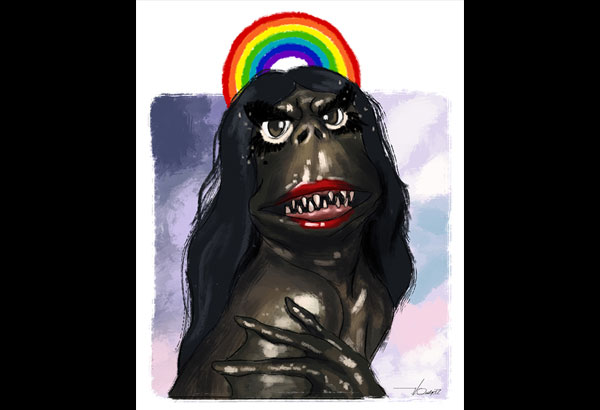POSTCRIPT:7 potential gay icons from the Filipino horror movies


Illustration by VINCENT QUILOP
There was a mix of surprise and glee when the internet put the Babadook in the pantheon of gay icons. What started out as an alleged listing of the horror film The Babadook under Netflix’s LGBT films expanded as a discourse on how the gaunt creature — with its flair for drama and a top hat as a statement piece — is an actual manifestation of the struggle that the LGBT community has gone through over the years. The initial interpretation of the Babadook as a representation of maternal grief and depression is apparently “a heterosexual thing.” A Tumblr user suggests, “A movie about a gay man who just wants to live his life in a small Australian suburb? It may be ‘just a movie’ to you but to the LGBT community the Babadook is a symbol of our journey.”
The phenomenon has sprouted a number of lists, memes and, interestingly, think pieces. Even The New Yorker has jumped in on the “Babadiscourse.” As Aaron Orbey puts it: “Like those other misunderstood figures, he (the Babadook) originated in anonymity, shunned by the traditional folks whom his presence threatened. The grieving widow of (Jennifer) Kent’s film discovers him in a frightening, flamboyant pop-up book on her son’s shelf. Fearing the creature’s transgressive influence — his shameless oddity, his aggressive manner — she attempts to burn his manifesto, only to learn that attempting to get rid of the Babadook actually enlivens him.”
These essential traits — “creatures” on the fringes of society, shunned and unloved — are basic components of any movie monster. No wonder Lady Gaga so fondly refers to her fans as “little monsters.”
So get ready for some stretching as we take a non-canonical look at the Filipino film monsterverse and list a few possible queer interpretations — just like in the Babadiscourse — of creatures that have appeared in movies.
Undin
From: Shake Rattle and Roll III - “Nanay” (Peque Gallaga and Lore Reyes, 1991)
What is it: According to Vangie Labalan’s Mommy Ebs, the supposed mythic creature is a cross between a cockroach, a fish and a lizard — more or less a “pest” that lives in lakes (“dormitoryo ng mga halimaw”). It has frog-like limbs, slimy skin, throws up acid at its foes, dissolving them in seconds. It is fiercely protective of its eggs.
Pride potential: Initial interpretations of the creature evoked maternal instincts and nature’s wrath but it might just well be an allegory about humans taking away LGBT rights (the eggs in the films), promptly smashing them out of glee and bigotry. The undin gives the bigots hard lessons and takes no sh*t from bullies. Manilyn Reynes remains an ally throughout the film.
Miguel Rodriguez’s “Manananaggal”
From: Shake Rattle and Roll IV - “Madre” (Peque Gallaga and Lore Reyes, 1992)
What is he: By day, a doctor helping the poor and by night, he “comes out” as a manananggal.
Pride potential: He represents how, for many years, members of the LGBT community had to be professionals or hold stable jobs, or at least be “presentable” to society, so they could be tolerated or accepted and assert their “worth” in the eyes of everyone else. And when they bare their real selves, they are persecuted (depicted in a harrowing scene where Lilia Cuntapay’s old lady character, accused of being a manananggal, is assaulted by the public).
Lotus Feet
From: Feng Shui and Feng Shui 2 (Chito S. Roño, 2004 and 2014)
What is it: The spirit of an abandoned Chinese girl residing in a bagua mirror.
Pride potential: The bound feet might as well be the imposition of heterosexual norms and the oppression against members of the LGBT community. Anyone who “looks” into the mirror symbolizes the judgmental people who have looked down on anyone who didn’t fit their societal conventions.
Halimaw sa Banga
From: Halimaw (Mario O’Hara, 1986)
What is it: An “evil” spirit cursed to languish in eternity in a mock-hell at the bottom of an ancient earthen jar which, centuries later, is excavated in an illegal expedition in Kalinga by an antique seller played by Liza Lorena (a Maleficent- like character).
Pride potential: There is no explanation offered in the film as to why the spirit was crucified (societal oppression), only that it is evil and should be rid from this earth. Upon its awakening, it “eats” a child (probably taking him away from clutches of actual evil humans — and there are plenty of them in the film), and eats a succession of boorish men who are pablings and are just simply deplorable. The spirit — which is not gendered in the film — also resists religious oppression and continues to wage battle against “heaven” (people who use religion to spread hate).
Lilia Cuntapay’s “Yaya”
From: Shake Rattle and Roll III - “Yaya” (Peque Gallaga and Lore Reyes, 1991)
What is it: A spirit bent on getting its hands on Kris Aquino’s baby.
Pride potential: It might seem that the yaya (Lilia Cuntapay) embodies the fear that “The gays are out to get your children!” but what if all it really wants is to protect the children from parents who won’t understand what their kids will become? From narrow-minded parents who will treat their own children as outcasts?
Alma Moreno’s “Aswang”
From: Aswang (Peque Gallaga and Lore Reyes, 1992)
What is it: A woman living alone in the woods who can shape-shift (drag) and eats babies while in their mother’s wombs.
Pride potential: Catlyn (Aiza Seguerra) is pursued by the criminals who robbed her house and killed her mother. Catlyn flees to Talisay where their family driver lives. The town is, coincidentally, the subject of an aswang attack, eating lewd, good-for-nothing men. She blends in with the town, conjures up an appearance so the townspeople won’t suspect her, much like the way some members of the LGBT community are forced to put on a facade and hide in the closet, or live in psychological isolation. The aswang reveals itself as a nurturing force, just like Cuntapay’s yaya, killing the murderers looking for Catlyn. She is protecting the child. And, as screenwriter and poet Wanggo Gallaga asks, “Was the aswang just after Aiza to help her realize that she would grow up to be a he?”
Killer Christmas Tree
From: Shake Rattle and Roll IX - “Christmas Tree” (Paul Daza, 2007)
What is it: A rare tree from the Amazon is bought by a family. It turns out that it is a “living” creature that eats a parrot which tried to disturb its peace, and the house help, a gay man, who insists on overdecorating it in time for the holidays.
Pride potential: Its killing of the help, played John Lapus, is symbolic of defeating the caricature portrayal of LGBT characters in media. The tree’s resistance to excessive tinsel and decoration also represents the march against stereotyping. The tree actually grows stronger as it eats its foes. And when it fully emerges, it has to “shed” its Christmas tree facade and is immediately looked upon with horror by people.















